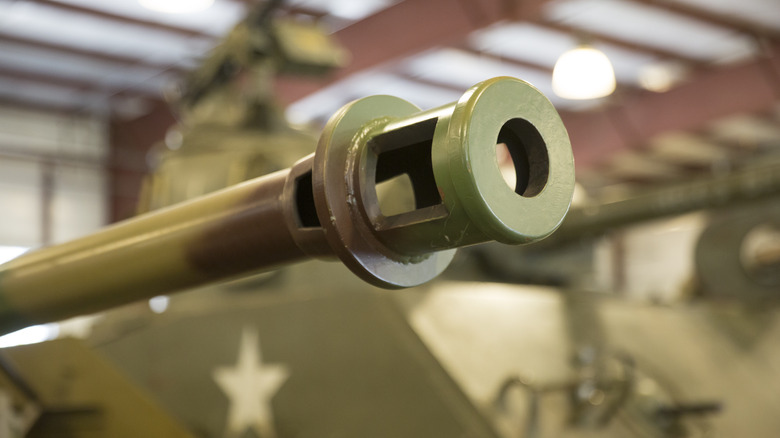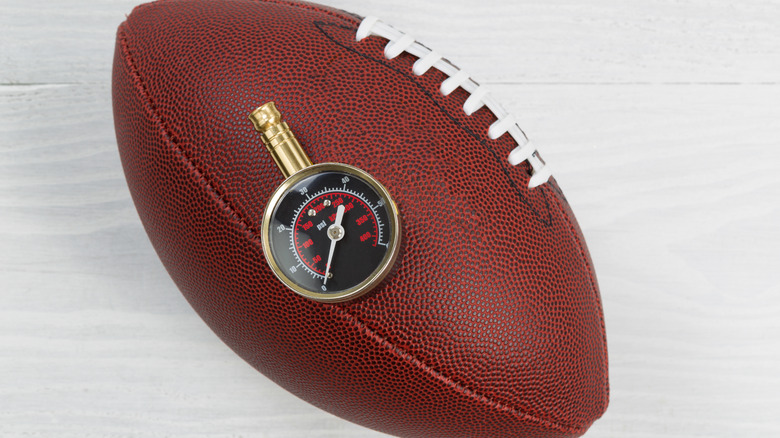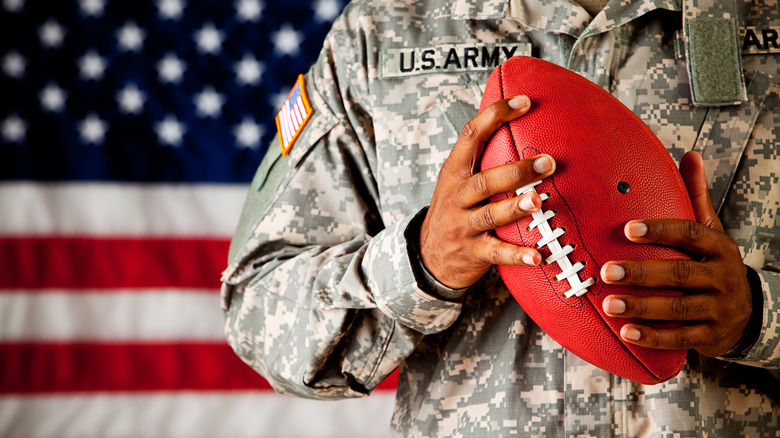The Strange Army Project That Turned Footballs Into Grenades
The United States military has been a formidable entity for generations. The military's reputation is solid throughout wars, battles, and general safe-keeping of the U.S. To uphold such a reputation requires both craft and cunning; over the years, Defense Department researchers have pushed the boundaries to their limits.
About one-third of the Department of Defense's budget is allotted to weaponry; this rich funding has yielded both significant breakthroughs and questionable creations. For example, a Bat Bomb might sound like something right out of a comic book, but it was actually the United States Marine Corps' idea for kamikaze bombers in the form of trained bats.
Comic books aren't the only place the U.S. military seems to take weaponry inspiration from either, because in 2016 they announced the need for invisibility cloaks. While the idea of invisibility cloaks sounds magical, it's a bit more scientific than that. Scientists reached a breakthrough on the project when they realized that by manipulating electromagnetic waves, they could make an object, like a fighter jet, virtually undetectable.
From farfetched ideas to technological breakthroughs, the United States military has tried just about everything imaginable in terms of weapon design, but what about the time they tried to blend American footballs and grenades? It wasn't exactly a touchdown.
The U.S. military found football's popularity inspiring
American football has been a beloved sport in the U.S. for decades. It seems that everyone at some point in their life has thrown a football at least once. The United States military took the nation's love of football and ran with it as far as possible. They worked under the assumption that most U.S. soldiers knew how to throw a football and knew how to throw one well.
Whether or not every soldier was an expert at tossing a football became irrelevant when the Department of Defense took inspiration from the sport's popularity and decided to make an explosive football. The explosive football's purpose was to take out enemy tanks. A soldier with the ability to throw a spiral, or throw well in general, would be able to toss the deadly pigskin lookalike at an armored vehicle and, with any luck, put it out of commission. So, in 1973, the exploding football project began.
The exploding football was meant to be a close-range tank destroyer
The United States military thought of just about every scenario in regard to combat possibilities, including the chance that there might be battles on the moon's surface at some point. Preparedness was a top priority. This explains why during the Cold War, NATO wanted to be as prepared as needed for close-range combat.
It was believed that a lot of the battles between U.S. troops and the Red Army's tanks would be in densely populated areas like cities. Brainstorming ways to minimize civilian casualty led the Army's Aberdeen Proving Ground to the idea of the football grenade. The hope was that the football-style hand grenade would be the perfect close-range weapon for blasting through the armor of enemy tanks.
The small size of a football grenade, mixed with the ability to be launched by the throw of a single soldier, gave the military hope that it would take out enemy tanks without giving away the soldier's position.
The football grenade was made to fit standard game regulations
A football that fits the regulations of the National Football League should be 11 to 11.5 inches in length and have a circumference of 22 inches. Each ball is inspected prior to kickoff and, in order to pass, needs to weigh between 14 and 15 ounces. When making the idea of a football-style grenade a reality, the regulations of game-worthy footballs were at the forefront of the design.
According to a quote from the official test report published by Rare Historical Photos, "Since a regulation-size football weighs 14 ounces, it was considered feasible to make a shaped charge grenade within this weight limitation."
It seems impossible to bring familiarity to an armor-penetrating explosive device, but the United States military attempted to do just that when they placed high hopes in American troops all not only knowing their way around a football, but being skilled at throwing them.
The original prototype was a deadly Nerf football
American football has long been popular with all ages. However, not all ages' hands fit comfortably around a standard NFL football, making the ball harder for younger sports fans to toss around. American toy and game manufacturer Parker Brothers sought to overcome this challenge and introduced the Nerf football.
The Nerf football is a lightweight and easy-to-grip polyurethane foam that makes enjoying the game possible for just about anyone. It was first introduced in 1969 and is still popular decades later. Just a few years after its release, the United States military briefly developed a football grenade. Their experimental model is speculated to have been a hollowed-out Nerf.
The original prototype for the football grenade came to be when the innards of a Nerf football were removed and replaced with armor-penetrating explosives. The football was then fitted with a hollow charge, which is an open cavity between the explosives in the grenade and the front of the casing. A copper liner is fitted in the device as well, turning it into an explosive and penetrating football. Unlike the standard Nerfs, though, this ball was definitely not suitable for children.
Before the exploding football came the exploding baseball
The technology of the United States military is no stranger to the occasional use of bizarre weaponry, and the football grenade is no different. Though, this deadly mechanism of NFL enthusiasm isn't even the United States' first venture into explosive sporting equipment.
Prior to the football grenade came the baseball grenade during World War II. The baseball version was a fragmentation grenade, designed for the iron casing housing the explosives to shatter into pieces and fly through the air as deadly projectiles. The grenade was inspired by a baseball due to the nation's love of the game, but was officially named the T-13 and affectionately called "Beano."
The T-13 was originally an experiment from the Office of Strategic Services (known today as the Central Intelligence Agency) and the U.S. military. However, the experiment was so short-lived that it didn't make it out of testing due to killing two people and injuring 44 throughout the process. It wasn't a complete failure though, as it helped introduce the replacement to the Mk 2 "pineapple" grenades, changing the shape to a sphere.
It turns out not everyone throws a football the same way
The football grenade may not have lasted long, but the aerodynamics of a football actually make it perfect for throwing. A football's shape allows wind torque to produce slight changes in the ball's angular momentum, keeping it in rotation around its trajectory. This spinning stabilizes the ball and keeps it in a spiral, ultimately helping it reach the thrower's intended target with accuracy and momentum.
The requirement for this to work is a skilled thrower behind the toss. The Army's expectation for throwing a fragmentation grenade is roughly 115 feet, and they believed that this wouldn't be challenging to achieve with the football grenade. The real challenge behind this theory came when the explosives tucked inside the football made it less predictable than a regular football. To add to the inconsistency, not every soldier going into battle possessed the same skill and form when it came to throwing a football. This created an inability to predict consistent range and accuracy for the weapon.
Engineers quickly realized this project wouldn't go as theorized
As the design for the football grenade went into testing, it became clear that implementing it would be a grave mistake. In theory, the spiral-controlled throwing of a football shape is great, but footballs have a tendency to bounce in irregular patterns. For the grenade, it was nearly impossible to predict when it would actually explode and what the casualty would be if not the intended target.
Engineers' attempt to make this grenade as close to regulation football standards as possible failed due to the hollowed-out portions of the weapon's inner casing. There was no way to achieve consistent direct impact due to the football bouncing, rotating, and inconsistent throws by soldiers.
In a passage published by The Drive, the Land Warfare Laboratory concluded that "[t]he football would bounce away before the nose rotated any significant amount. In addition, the football never attained a stable trajectory. This was apparently caused by the mass of the grenade-type football being near the longitudinal axis while a real football has all its weight in the skin. The football shape was not considered practical for further development." This was more than likely the right call to make prior to any possible battlefield casualties.







